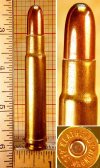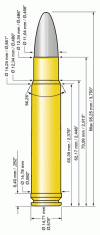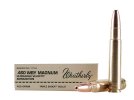monish
AH elite
.460 Weatherby Magnum
The .460 Weatherby Magnum is a rifle cartridge, developed by Roy Weatherby in 1958. It is simply the .378 Weatherby Magnum necked up to accept the .458 inches (11.6 mm) bullet. This case is now made commercially from virgin brass. The original .378 Weatherby Magnum case was based on a belted version of the .416 Rigby.
The .460 is the world's most powerful commercial cartridge, in terms of both velocity and bullet weight. The .460 will launch a 500 grains (32 g) bullet at a chronographed 2,700 ft/s (820 m/s) from a 26 inches (660 mm) barrel; measuring 8,100 ft•lbf (11,000 J) of muzzle energy.
Recoil is a problem for many shooters when using a cartridge of this size. Even with a 12 lb (5.4 kg) rifle (scope, base, rings and cartridges included) the recoil against the shooter's shoulder is measured at 100 ft•lbf (140 J). Compare this to most rifles chambered in .30-06 Springfield which develop an average of 20 ft•lbf (27 J) of free recoil. For many years the Weatherby Mark V rifles chambered in 460 Weatherby were equipped with a Pendleton muzzle brake to help alleviate this effect.
Recently Weatherby has offered some reduced loads in the 7,500 ft•lbf (10,200 J) range, in order to be more forgiving to shooters. The recoil of the full-power loads is very punishing and if the gun has a scope, scope cuts on the forehead are common. For that reason, many gun owners reload their cartridges with a lighter-than-factory charge. A factory powder charge for this cartridge is about 115 grains (7.5 g).
The .460 is primarily an elephant gun and is typically equipped with only open sights. Open sights tend to sight in quicker than scoped rifles and for this reason open sighted rifles are preferred by hunters for back-up work-when the hunter and/or guide must mount and discharge their firearm to ensure a charging game animal does not hurt a client or ensure a clean kill of a wounded game animal. It also prevents the hunter from getting his eyebrow cut by the scope, which is common with a firearm with as much recoil as this one.
This cartridge is very accurate despite its size. Typically a full metal jacketed or monolithic solid type bullet will penetrate more than 40 in (1.0 m) when impacting a dangerous game animal such as the Cape Buffalo or African Elephant. The .460 Weatherby Magnum has few peers for stopping dangerous African game. Many hunters and guides carry this firearm exclusively for back-up work.
The .460 Weatherby Magnum is primarily a thick skinned dangerous game cartridge. It is designed to provide the ultimate in stopping power against elephant, cape buffalo and the rhinoceros. It has more than the required energy necessary to drive 500–600-grain (32-39 g) bullets into the elephant's vital organs from any angle provided that bullet is up to the task. Generally, elephants require solid bullets.
Bullets in the 450-500-grain (29-32 g) range are excellent for African cape buffalo and rhinoceros. A combination of solids and expanding bullets may be used against these big game. Expanding bullets should be of the controlled expansion variety.
The .460 Weatherby is overly powerful for lion or leopard. Lion are thin skinned and weigh no more than 600 lb (270 kg) while leopards weigh no more than 250 lb (110 kg). When the .460 Weatherby is used for hunting leopard or lion, a rapidly expanding bullet is normally used. Bullet ideal for lion or leopard begin with the 350-grain (23 g) bullets.
The .460 Weatherby is one of the very few rifle cartridges approved by the International Whaling Commission for the harvesting of whales. The Makah people of the Pacific Northwest have used this rifle cartridge for decades hunting whales.
While the .460 Weatherby Magnum is powerful cartridge, it cannot make up for inexperience or poor marksmanship. As with any rifle cartridge that produces heavy recoil, recovery time between subsequent shots should be taken into account when choosing such cartridges for hunting dangerous game.
North American big game does not require the full power of the .460 Weatherby Magnum. Harvesting of bison, elk, moose and brown bear can be accomplished by reducing the performance of the cartridge to match the requirements. The .460 Weatherby Magnum cartridge has the flexibility to loaded to duplicate the performance of the .45-70 Government to the .450 Rigby .An advantage is the significantly lower recoil of such loadings.
Type Centerfire/Rifle
• Place of origin: South Gate, California
• Production history: Designer Roy Weatherby
• Designed 1958
• Manufacturer Weatherby Inc.
Specifications
• Parent case: .378 Weatherby Magnum
• Case type: Belted, bottleneck
• Bullet diameter: .458 in (11.6 mm)
• Neck diameter: .481 in (12.2 mm)
• Shoulder diameter: .560 in (14.2 mm)
• Base diameter: .582 in (14.8 mm)
• Rim diameter: .603 in (15.3 mm)
• Rim thickness: .059 in (1.5 mm)
• Case length: 2.908 in (73.9 mm)
• Overall length: 3.65 in (93 mm)
• Rifling twist: 1 in 16"
• Primer type
• Large rifle magnum
• Maximum pressure: 65,000 psi (450 MPa)
Ballistic performance
Bullet weight/type - Velocity - Energy
• 500 gr (32 g) FMJ - 2,600 ft/s (790 m/s) - 7,504 ft•lbf (10,174 J)
• 500 gr (32 g) Round Nose - 2,600 ft/s (790 m/s) - 7,504 ft•lbf (10,174 J)
• 450 gr (29 g) Truncated Solid - 2,660 ft/s (810 m/s) - 7,072 ft•lbf (9,588 J)
• Test barrel length: 26 inches (660 mm)
Monish
The .460 Weatherby Magnum is a rifle cartridge, developed by Roy Weatherby in 1958. It is simply the .378 Weatherby Magnum necked up to accept the .458 inches (11.6 mm) bullet. This case is now made commercially from virgin brass. The original .378 Weatherby Magnum case was based on a belted version of the .416 Rigby.
The .460 is the world's most powerful commercial cartridge, in terms of both velocity and bullet weight. The .460 will launch a 500 grains (32 g) bullet at a chronographed 2,700 ft/s (820 m/s) from a 26 inches (660 mm) barrel; measuring 8,100 ft•lbf (11,000 J) of muzzle energy.
Recoil is a problem for many shooters when using a cartridge of this size. Even with a 12 lb (5.4 kg) rifle (scope, base, rings and cartridges included) the recoil against the shooter's shoulder is measured at 100 ft•lbf (140 J). Compare this to most rifles chambered in .30-06 Springfield which develop an average of 20 ft•lbf (27 J) of free recoil. For many years the Weatherby Mark V rifles chambered in 460 Weatherby were equipped with a Pendleton muzzle brake to help alleviate this effect.
Recently Weatherby has offered some reduced loads in the 7,500 ft•lbf (10,200 J) range, in order to be more forgiving to shooters. The recoil of the full-power loads is very punishing and if the gun has a scope, scope cuts on the forehead are common. For that reason, many gun owners reload their cartridges with a lighter-than-factory charge. A factory powder charge for this cartridge is about 115 grains (7.5 g).
The .460 is primarily an elephant gun and is typically equipped with only open sights. Open sights tend to sight in quicker than scoped rifles and for this reason open sighted rifles are preferred by hunters for back-up work-when the hunter and/or guide must mount and discharge their firearm to ensure a charging game animal does not hurt a client or ensure a clean kill of a wounded game animal. It also prevents the hunter from getting his eyebrow cut by the scope, which is common with a firearm with as much recoil as this one.
This cartridge is very accurate despite its size. Typically a full metal jacketed or monolithic solid type bullet will penetrate more than 40 in (1.0 m) when impacting a dangerous game animal such as the Cape Buffalo or African Elephant. The .460 Weatherby Magnum has few peers for stopping dangerous African game. Many hunters and guides carry this firearm exclusively for back-up work.
The .460 Weatherby Magnum is primarily a thick skinned dangerous game cartridge. It is designed to provide the ultimate in stopping power against elephant, cape buffalo and the rhinoceros. It has more than the required energy necessary to drive 500–600-grain (32-39 g) bullets into the elephant's vital organs from any angle provided that bullet is up to the task. Generally, elephants require solid bullets.
Bullets in the 450-500-grain (29-32 g) range are excellent for African cape buffalo and rhinoceros. A combination of solids and expanding bullets may be used against these big game. Expanding bullets should be of the controlled expansion variety.
The .460 Weatherby is overly powerful for lion or leopard. Lion are thin skinned and weigh no more than 600 lb (270 kg) while leopards weigh no more than 250 lb (110 kg). When the .460 Weatherby is used for hunting leopard or lion, a rapidly expanding bullet is normally used. Bullet ideal for lion or leopard begin with the 350-grain (23 g) bullets.
The .460 Weatherby is one of the very few rifle cartridges approved by the International Whaling Commission for the harvesting of whales. The Makah people of the Pacific Northwest have used this rifle cartridge for decades hunting whales.
While the .460 Weatherby Magnum is powerful cartridge, it cannot make up for inexperience or poor marksmanship. As with any rifle cartridge that produces heavy recoil, recovery time between subsequent shots should be taken into account when choosing such cartridges for hunting dangerous game.
North American big game does not require the full power of the .460 Weatherby Magnum. Harvesting of bison, elk, moose and brown bear can be accomplished by reducing the performance of the cartridge to match the requirements. The .460 Weatherby Magnum cartridge has the flexibility to loaded to duplicate the performance of the .45-70 Government to the .450 Rigby .An advantage is the significantly lower recoil of such loadings.
Type Centerfire/Rifle
• Place of origin: South Gate, California
• Production history: Designer Roy Weatherby
• Designed 1958
• Manufacturer Weatherby Inc.
Specifications
• Parent case: .378 Weatherby Magnum
• Case type: Belted, bottleneck
• Bullet diameter: .458 in (11.6 mm)
• Neck diameter: .481 in (12.2 mm)
• Shoulder diameter: .560 in (14.2 mm)
• Base diameter: .582 in (14.8 mm)
• Rim diameter: .603 in (15.3 mm)
• Rim thickness: .059 in (1.5 mm)
• Case length: 2.908 in (73.9 mm)
• Overall length: 3.65 in (93 mm)
• Rifling twist: 1 in 16"
• Primer type
• Large rifle magnum
• Maximum pressure: 65,000 psi (450 MPa)
Ballistic performance
Bullet weight/type - Velocity - Energy
• 500 gr (32 g) FMJ - 2,600 ft/s (790 m/s) - 7,504 ft•lbf (10,174 J)
• 500 gr (32 g) Round Nose - 2,600 ft/s (790 m/s) - 7,504 ft•lbf (10,174 J)
• 450 gr (29 g) Truncated Solid - 2,660 ft/s (810 m/s) - 7,072 ft•lbf (9,588 J)
• Test barrel length: 26 inches (660 mm)
Monish




